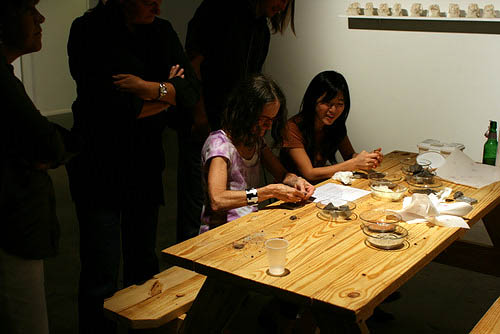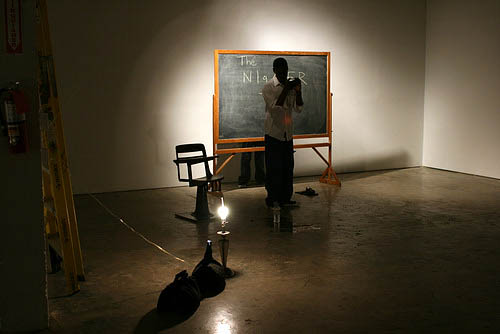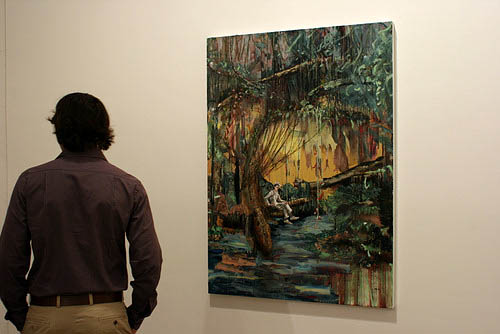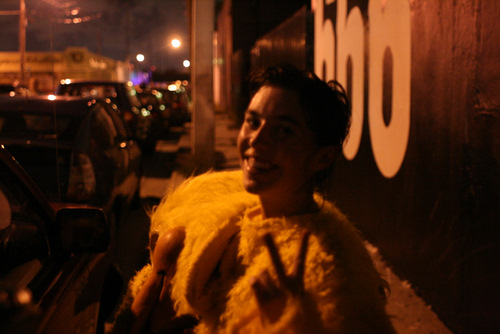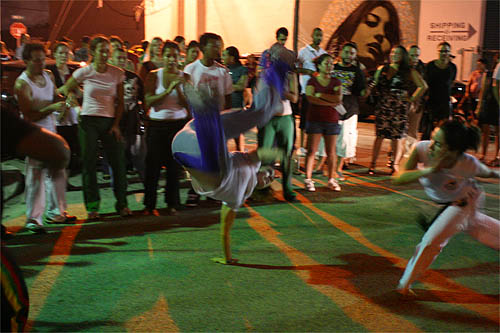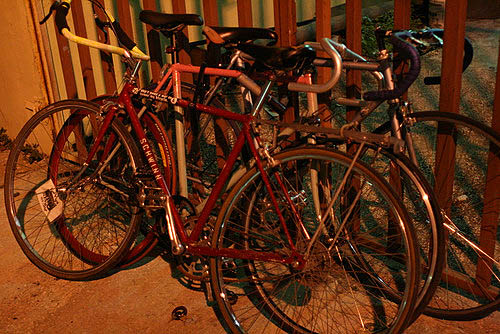“Leyner and Vollman and Daitch, Amy Homes, Jon Franzen, Lorrie Moore, Rick Powers, even McInerney and Leavitt” (Source. BTW, I’m just finishing up my first Mark Leyner book, was somewhat disappointed with Amy Homes, and have become a big Franzen fan.)
More fun with Broward County lawns
Fresh Air
 Who’s the best interviewer on TV or radio? Charlie Rose? Larry King? Please. To some extent it’s a subjective question, your answer possibly skewed by your preferences in guests. For me, the answer lately has been Fresh Air’s Terry Gross. Her bio talks about her empathy with her guests, and that’s certainly a big thing, but the thing that is key to her success is a palpable curiosity that is rarely matched by television and radio personalities. Nothing is more disturbing then listening to an interviewee say something super-interesting, and the interviewer goes down to the next question on their little piece of paper, as if they had cotton in the ears. I’ve seen Charlie Rose actually cut people off sometimes (and here I’m not talking about political interviews, when cutting people off is not done nearly enough, at least in this country). Gross is right there with a spot-on followup question, inevitably better then the one I was hoping she’d ask. Too, her interviews have a satisfying quality, such that when she does 18 minutes with someone, she almost always seems to have gotten the best 18 minutes out of that person there was to get.
Who’s the best interviewer on TV or radio? Charlie Rose? Larry King? Please. To some extent it’s a subjective question, your answer possibly skewed by your preferences in guests. For me, the answer lately has been Fresh Air’s Terry Gross. Her bio talks about her empathy with her guests, and that’s certainly a big thing, but the thing that is key to her success is a palpable curiosity that is rarely matched by television and radio personalities. Nothing is more disturbing then listening to an interviewee say something super-interesting, and the interviewer goes down to the next question on their little piece of paper, as if they had cotton in the ears. I’ve seen Charlie Rose actually cut people off sometimes (and here I’m not talking about political interviews, when cutting people off is not done nearly enough, at least in this country). Gross is right there with a spot-on followup question, inevitably better then the one I was hoping she’d ask. Too, her interviews have a satisfying quality, such that when she does 18 minutes with someone, she almost always seems to have gotten the best 18 minutes out of that person there was to get.
Her choice in guests in my opinion over-relies on the film industry (and I just flat don’t understand why she doesn’t regularly feature contemporary visual artists), but otherwise it is pretty excellent. She doesn’t do political figures, but frequently features experts who have vital information that ought to be factoring into our political decisions.
A few recent Fresh Air segments I do not recommend to be missing:
- James Bamford on the National Security Administration, including how the NSA refused to share information with the CIA before 9/11, about absurdly misused computer technology, and on systematic eavesdropping on conversations between soldiers in Iraq and their wives.
- Jane Mayer on the Bush administration’s anti-terror policies.
- Your man Krugman taking a bow for his Nobel and breaking down the deal with the Current Financial Crisis (although in this regard almost better to check out Another Frightening Show About the Economy on This American Life).
- Michael Pollan on food and US food policy.
Some older things I’ve recommended previously:
- Philippe Sands says Bush administration officials, including Bush and Cheney, have a decent chance of being tried for war crimes at some point in the future!
- Everything you know about Iran is wrong!!
Obama tax calculator
The Obama tax calculator. Frankly, this is what I like least, and find most cynical, about the Obama candidacy: “vote for me, and I’ll give you money.” This sort of thing exposes the weakness in the very idea of a popular democracy, and I wish that a candidate with Obama’s rational appeal (not to mention with Obama’s near-lock on winning) would resist engaging in that kind of pandering.
Salon predicts another election disaster in Florida
Salon predicts another election disaster in Florida. Actually, the trouble has already started — lots of people have reported the early-voting problems the article references (why anyone would want to vote as soon as possible escapes me), we have brand new voting machines, droves of new voters, and this cockamamie new “no match, no vote” law (which is almost like Charlie Christ looking for a way to make himself less popular (but nevermind, because I got my address change in, so I’m good to go)).
Great moments in post-modernism, pt. 1 (More Money, More Problems)
I came across this old nugget while doing research for my forthcoming comprehensive appreciation of Missy Elliot’s work. This track, credited to Notorious B.I.G. (his second posthumous #1 hit single, an all-time record), is really a Puffy vehicle, and one of the strangest bits of art to make it onto MTV in the 90s. We open with a parody of a climactic moment of a golf tournament, Puffy playing a Tiger Woods character, cut to a “conventional” rap video, back to a bit of golf footage, back to rap video, then to some home-video of Biggy rambling, then cut to more rap video footage, now with a primo verse of posthumous Biggy spliced in from some abandoned track* (this is far and away the highlight of the whole thing), and then back to the previously scheduled song. The hook is lifted from a Diana Ross track (re-recorded), but what holds the track together is the line “more money, more problems,” repeated in the golf skit and in Biggy’s candid monologue.
When I saw this video in 1997 I loved it immediately, and for two reasons. One was the (* not so conventional, really) completely new vision of a bright shiny approach to hip-hop. Credit for this of course goes to Hype Williams, who directed the video, and who’d certainly directed equally eye-popping videos before. This one, though, sunk into my consciousness as much as (and just before) Missy’s I can’t Stand the Rain. The 90’s were a desolate time for rap, where the gangsta (sp?) ruled, and it was all about pictures of yourself and your crew in baggy denim and Timberlands in a bleak urban landscape, and all about your flow. It seems quaint now, but the idea that rap could be Glam again (like it had been in in the mid 80s) struck like a hammer. So did Mase’s lackadaisical flow, which seemed like a challenge to the silver-tongued MC’s of the day (e.g. DMX, who you may not remember being that fierce, but really, he kind of was) that ruled in those days, and of course Puff Daddy’s rapping was that much closer to a joke from a conventional perspective — dude got over purely on personality, and plus being the dude who’s business acumen built the building in which the party was taking place.
But much more then that, what hit home was the song’s frank discourse with reality. The toss-off line “more money more problems,” which the posthumous Biggie attributes to Puffy (who’s really creating the song, follow?), seems to accuse the whole post-barter system of human trade of being a way of keeping the little guy (ie the black man) down. Success = problems, or so it sounded to me at the time. I don’t think anyone cared at the time whether this very real critique held any merit — what was so powerful was that it sounded true, and that it helped break the mold of a pop-song, propelled it into something that looked like a particularly biting form of social commentary.
This really strikes home in the middle of Biggy’s verse, when we’re treated to a brief shot of a party with several dozen women dancing, while the song tries to to sell the idea that its grandiose concept is based on a seed in B.I.G.‘s words. Of course, this leads us to an inevitable conclusion: that Biggie’s death was somehow the result of his success. More money leads to more problems, most money leads to getting gunned down by a never-to-be-identified assailant. That is some strong medicine, and in terms of the alleged exploitation of the Notorious B.I.G.‘s death for commercial gain, challenges even the sappy ballad I’ll be Missing You.
So there it is: a weird/powerful truism about social politics delivered in a catchy, post-modern package that uses parody, found video, and cutting-edge video techniques (and let’s not sell Hype Williams short for a second — check out the shots of Puffy and Mase in the yellow suits — I mean, what the hell is that?!), all montaged together with an off-handed mastery (check out how some of the transitions are deliberately not on-beat) to create something that felt so like the future that it could never really be the future. Just like all videos for pop singles, it was dug, and it was forgotten. And so it goes. Somewhere out there there is a list of videos that really truly did something new, and this one belongs on that list.
Correction: While the single and the album it appears on were released after Biggie’s death, the song was almost certainly created while he was still alive, with everything as it appears except the 2-part golf skit.
30 Rock S03E01 on Hulu
30 Rock S03E01 on Hulu, a full week before the on-air broadcast. I take back whatever smack I may have talked about Hulu in the past. This is the future of TV.
A little light reading, 1
Um, so the underlined things in all the stuff I’ve been writing are hyperlinks, and they usually point to things that I thought were worth reading or whatever. Most of y’all never click them, and that’s fine, but it bears mentioning. Here are some things that are also probably worth reading:
- Malcom Gladwell on genius. Honestly, I’d point you to anything Gladwell wrote. If you haven’t read his books, run, don’t walk. (And/or at least check him out talking about spaghetti sauce.)
- Maureen Dowd on Colin Powell’s justified indignation towards the McCain campaign. I generally find Dowd way overrated, but this is a really good column.
- John Swansburg on what happens when a big group goes out to eat (i.e. the bill gets bloated and the whole thing sucks), plus three strategies for approaching the situation.
- Irene Dieter on whether Nader cost Gore the 2000 election. I’ve been having an e-mail debate about this with a friend, and this is the latest link she sent me. I still say the voters who voted for Nader in Florida are as much to blame as anything else.
- Wikipedia page on Go, the greatest board game ever.
- Gizmodo on Brian Eno’s iPhone app. Of which there’s not much to say more then, if you needed one more reason to take the $80/month plunge…
- Jeffrey Goldberg on the BS that is the screening process at airports. I actually have yet to read this, but since re-discovering the Atlantic recently I’ve been having a blast over there.
WTF?
A certain shady South Florida “museum” has been sending me spam at regular intervals with the following message affixed to the top of the message:
This e-mail has been classified as WHITE MAIL by AOL (America On Line).
This mail is originated by a 501©(3) non profit cultural organization and cannot be considered as Spam. You have the right to be DELETED from our mailing list sending back this email with the word UNSUBSCRIBE on the subject. This mail has been sent with the authorization of AOL (America On Line) and according the U.S. laws. Thank you.
Is it just me, or is this weird three ways to Sunday and back? Anyone seen anything like this or have any explanation whatsoever?
Arthop, Miami, October ’08
We begin at Gallery Diet, with Samantha Salzinger’s spectacular photos. By the way, I just built her a website. Anybody else want one? Get in touch.
Peggy and Harumi make stones at Mark Kowen’s show at Dorsch.
The rest of the gallery is filled with several dumptrucks worth of sand dunes, and a catapult/crossbow type device where you can launch someone else’s stone after you’ve made one of your own.
In the smaller space, an impromptu Classroom. The schedule is filling up.
Hernan Bas delivers new work at Snitzer — several spectacular large-scale paintings, and a large series of fairly abstract pencil drawings.
Clifton Childree’s installation at Locust Projects, the result of a two-month residency. Try to stop in at Locust if you haven’t seen this — they’re open Saturday afternoons until 5.
The chicken person, unmasked!
Looked like break-dancing to tribal beats to me. Major festivities in the streets despite a partial ban on alcohol. Apparently word got out (perhaps partially my fault), and during the September gallery walk crowds of fools showed up with the sold intention of getting drunk for free, got all sorts of rowdy, and knocked over a sculpture in World Class Boxing, resulting in aforementioned ban. I don’t give it more then one more month.
Towards the end of the night, a legion of cyclists showed up, their rides chained up in twos and threes up and down 24th. Check: one of the three bikes pictured has brakes.


